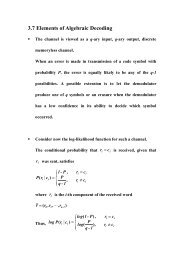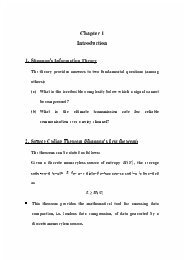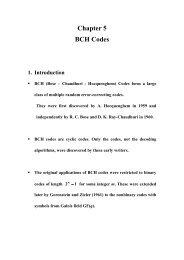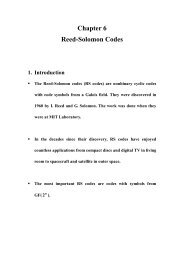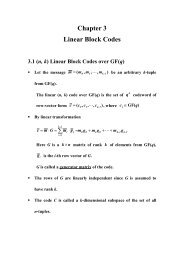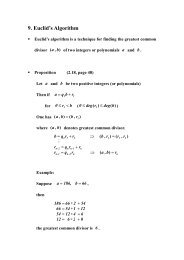Type of Errors Type of Channels
You also want an ePaper? Increase the reach of your titles
YUMPU automatically turns print PDFs into web optimized ePapers that Google loves.
<strong>Type</strong> <strong>of</strong> <strong>Errors</strong><br />
<br />
Random errors and burst errors.<br />
<strong>Type</strong> <strong>of</strong> <strong>Channels</strong><br />
<br />
Random error channels:<br />
Deep space channel, satellite channels, line <strong>of</strong> sight transmission<br />
channel, etc.<br />
<br />
Burst error channels:<br />
Radio links, terrestrial microwave links, wire and cable<br />
transmission channels, etc.
Decoding<br />
Suppose a codeword corresponding to a message is transmitted over<br />
a noisy channel.<br />
Let r be the received sequence. Based on r , the encoding rules<br />
and the noise characteristics <strong>of</strong> the channel, the receiver (or<br />
decoder) makes a decision which message was actually<br />
transmitted.<br />
This decision making operation is called “decoding”. The device<br />
which performing the decoding operation is called a “decoder”.<br />
<br />
Two types <strong>of</strong> decoding:<br />
Hard-decision decoding and s<strong>of</strong>t-decision decoding.<br />
<br />
Hard-decision decoding:<br />
When binary coding is used, the modulator has only binary<br />
inputs. If binary demodulator output quantization is used, the<br />
decoder has only binary inputs. In this case, the demodulator is<br />
said to make hard decisions.
Decoding based on hard decision made by the demodulator is<br />
called “hard decision decoding”.<br />
<br />
S<strong>of</strong>t-decision decoding:<br />
If the output <strong>of</strong> demodulator consists <strong>of</strong> more than two<br />
quantization levels or is left unquantized, the demodulator is said<br />
to make s<strong>of</strong>t decisions.<br />
Decoding based on s<strong>of</strong>t decision made by demodulator is called<br />
s<strong>of</strong>t-decision decoding.<br />
Hard-decision decoding is much easier to implement than<br />
s<strong>of</strong>t-decision decoding. However, s<strong>of</strong>t-decision decoding <strong>of</strong>fers<br />
much better performance.
Some Channel Models<br />
<br />
Binary Symmetric Channel (BSC)<br />
<br />
<br />
<br />
<br />
<br />
<br />
<br />
<br />
<br />
<br />
p: transition probability<br />
When BPSK modulation is used over the AWGN channel with<br />
optimum coherent detection and binary output quantization, the<br />
bit-error probability for equally likely signal is given by<br />
p = Q(<br />
2E<br />
N 0<br />
)<br />
where<br />
Q(x) ≡<br />
1<br />
2π<br />
∫∞<br />
x<br />
e<br />
2<br />
y<br />
−<br />
2<br />
dy<br />
E : bit energy<br />
N 0<br />
2<br />
: power spectral density <strong>of</strong> AWGN
Binary-input, 8-ary Output Discrete Channel<br />
<br />
<br />
<br />
<br />
<br />
<br />
<br />
<br />
<br />
<br />
<br />
<br />
Optimum Decoding<br />
<br />
Suppose the codeword c corresponding to a certain message<br />
m is transmitted. Let r<br />
be the corresponding output <strong>of</strong> the<br />
demodulator.<br />
The decoder produces an estimate mˆ <strong>of</strong> the message based on<br />
r .
An optimum decoding rule is that minimize the probability <strong>of</strong> a<br />
decoding error. That is, P( cˆ ≠ c | r ) is minimized. Or,<br />
equivalently, maximizing P ( cˆ = c | r ) .<br />
The decoding error is minimized for a given r by choosing ĉ<br />
to be a codeword c that maximizes<br />
P ( c | r ) =<br />
P(<br />
r | c ) P(<br />
c )<br />
P(<br />
r )<br />
That is, ĉ is chosen to be the most likely codeword, given that<br />
r<br />
is received.<br />
Maximum a posteriori decoding (MAP decoding)<br />
<br />
In general, we have<br />
P ( c | r ) =<br />
P(<br />
r | c ) P(<br />
c )<br />
P(<br />
r )<br />
If knowledge or an estimation <strong>of</strong> P(c<br />
)<br />
is used for decoding, the<br />
technique is called MAP decoding.
Maximum Likelihood Decoding (MLD)<br />
<br />
Suppose all the messages are equally likely. An optimum<br />
decoding can be done as follows:<br />
For every codeword<br />
c<br />
j , compute the conditional probability<br />
The codeword<br />
c<br />
j<br />
P<br />
r | c<br />
(<br />
j<br />
)<br />
with the largest conditional probability is<br />
chosen as the estimate ĉ for the transmitted codeword c .<br />
This decoding rule is called the Maximum Likelihood decoding<br />
(MLD).<br />
<br />
MLD for a BSC<br />
Let a = a ,a , L,<br />
) and b = b ,b , L,<br />
) be two binary<br />
(<br />
1 2<br />
an<br />
(<br />
1 2<br />
bn<br />
sequences <strong>of</strong> n components. The Hamming distance between<br />
a and b , denoted as ( a, b )<br />
d H<br />
places where a and b differ.<br />
, is defined as the number <strong>of</strong><br />
In coding for a BSC, every codeword and every received<br />
sequence are binary sequences.<br />
Suppose some codeword is transmitted and the received sequence<br />
is r = r ,r , L,<br />
)<br />
(<br />
1 2<br />
rn
For a codeword<br />
c , the conditional probability P r | c )<br />
i<br />
P r | c =<br />
p<br />
1 - p<br />
dH<br />
( r,ci<br />
) n-dH<br />
( ci<br />
)<br />
( ) ( )<br />
r,<br />
i<br />
(<br />
i<br />
is<br />
For<br />
1<br />
p < , P( r | ci<br />
)<br />
2<br />
is a monotonically decreasing function <strong>of</strong><br />
d r, c ) .<br />
H<br />
(<br />
i<br />
Then P r | c ) > P(<br />
r | c ) if and only if<br />
(<br />
i<br />
j<br />
d<br />
H<br />
( r,ci<br />
) < d<br />
H<br />
( r, c<br />
j<br />
)<br />
The MLD is completed by the following steps:<br />
(i) Compute d<br />
H<br />
( r, ci<br />
) for all i<br />
(ii)<br />
c<br />
ci<br />
is taken as the transmitted codeword if<br />
d r,c ) < d ( r, c ) for j ≠ i<br />
H<br />
(<br />
i H j<br />
(iii) Decode<br />
ci<br />
into message mi<br />
That is, the received vector r is decoded into the closest<br />
codeword.<br />
This is also called the minimum distance (nearest neighbor)<br />
decoding.
Bounded Distance Decoding<br />
<br />
Given a received word r , a t-error correcting, bounded distance<br />
decoder selects that codeword c which minimizes ( r, c )<br />
d H<br />
if<br />
and only if there exists c such that<br />
d H<br />
( r,c ) ≤<br />
t<br />
.Ifnosuch<br />
c exists, then a decoder failure is declared.<br />
All practical bounded distance decoder use some form <strong>of</strong><br />
syndrome decoding.<br />
The bounded distance decoding is usually an “incomplete<br />
decoding” since it decodes only those received words lying in a<br />
radius-t sphere about a codeword.



